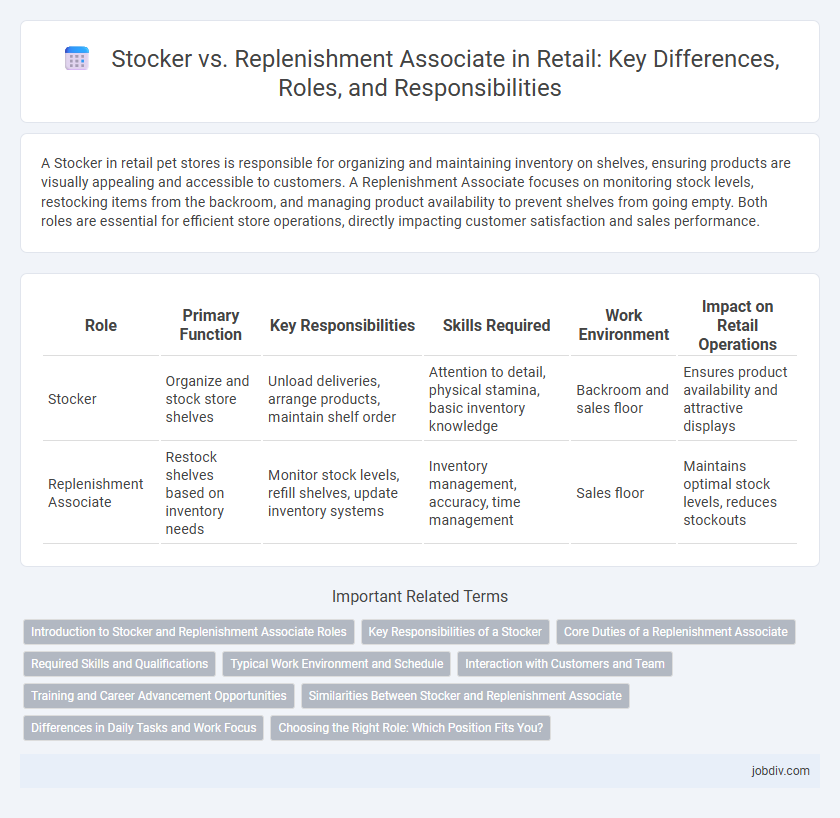A Stocker in retail pet stores is responsible for organizing and maintaining inventory on shelves, ensuring products are visually appealing and accessible to customers. A Replenishment Associate focuses on monitoring stock levels, restocking items from the backroom, and managing product availability to prevent shelves from going empty. Both roles are essential for efficient store operations, directly impacting customer satisfaction and sales performance.
Table of Comparison
| Role | Primary Function | Key Responsibilities | Skills Required | Work Environment | Impact on Retail Operations |
|---|---|---|---|---|---|
| Stocker | Organize and stock store shelves | Unload deliveries, arrange products, maintain shelf order | Attention to detail, physical stamina, basic inventory knowledge | Backroom and sales floor | Ensures product availability and attractive displays |
| Replenishment Associate | Restock shelves based on inventory needs | Monitor stock levels, refill shelves, update inventory systems | Inventory management, accuracy, time management | Sales floor | Maintains optimal stock levels, reduces stockouts |
Introduction to Stocker and Replenishment Associate Roles
Stocker and Replenishment Associate roles are vital in retail operations, ensuring shelves are consistently stocked and inventory levels meet customer demand. Stockers primarily focus on unloading merchandise, organizing stock rooms, and arranging products on shelves to maintain store presentation. Replenishment Associates concentrate on monitoring inventory, restocking products efficiently, and collaborating with team members to optimize product availability and reduce stockouts.
Key Responsibilities of a Stocker
A Stocker in retail is responsible for organizing and arranging merchandise on shelves to ensure optimal product visibility and accessibility. They unload delivery trucks, check inventory counts, and identify damaged or expired items for removal. Stockers maintain clean and safe stock areas while collaborating with the replenishment team to support continuous product availability.
Core Duties of a Replenishment Associate
Replenishment Associates primarily ensure timely restocking of merchandise on retail shelves to maintain optimal inventory levels and enhance customer satisfaction. They monitor inventory data and collaborate with stockers to manage backroom supplies efficiently, preventing stockouts and overstock situations. Regularly updating product displays and verifying pricing accuracy are also key responsibilities that support seamless store operations.
Required Skills and Qualifications
Stockers require strong organizational skills, attention to detail, and physical stamina to efficiently manage inventory placement and maintain store appearance. Replenishment Associates need excellent time management, inventory control knowledge, and the ability to respond swiftly to product demand fluctuations. Both roles benefit from teamwork, basic math skills, and familiarity with inventory management systems to ensure timely product availability.
Typical Work Environment and Schedule
Stockers typically work in cooler or warehouse areas, often during overnight or early morning shifts to prepare shelves before store opening. Replenishment associates operate mostly on the sales floor during business hours, restocking products in real time to maintain inventory levels. Both roles demand physical stamina and the ability to handle dynamic retail environments with varying schedules based on store hours and peak shopping periods.
Interaction with Customers and Team
Stockers primarily focus on organizing and stocking products efficiently, maintaining seamless inventory flow, and generally have limited direct interaction with customers. Replenishment Associates actively engage with team members to coordinate product availability and often assist customers by answering questions and locating items on the sales floor. Both roles require strong teamwork and communication skills, but Replenishment Associates typically have a more customer-facing and collaborative role within the retail environment.
Training and Career Advancement Opportunities
Stockers primarily focus on organizing merchandise and maintaining inventory accuracy, requiring training in inventory management and basic equipment handling. Replenishment Associates receive advanced training in supply chain processes, demand forecasting, and shelf replenishment techniques, positioning them for roles in inventory control and logistics management. Career advancement for Replenishment Associates typically includes pathways to supervisory or inventory specialist positions due to their in-depth operational knowledge.
Similarities Between Stocker and Replenishment Associate
Stockers and replenishment associates both play crucial roles in maintaining inventory levels and ensuring product availability on retail shelves. They share responsibilities such as unloading shipments, organizing stock in the storage area, and restocking shelves to meet customer demand efficiently. Both positions require attention to detail, physical stamina, and familiarity with inventory management systems to support seamless retail operations.
Differences in Daily Tasks and Work Focus
Stockers primarily focus on organizing and shelving products to maintain store inventory visually appealing and accessible, while replenishment associates concentrate on refilling stock from storage to sales floor to prevent out-of-stock situations. Stockers handle tasks related to product placement, including labeling and ensuring correct pricing, whereas replenishment associates monitor inventory levels and prioritize high-demand items for timely restocking. Both roles require attention to detail, but stockers emphasize display aesthetics, and replenishment associates focus on inventory flow efficiency.
Choosing the Right Role: Which Position Fits You?
Stockers focus on organizing and stocking shelves efficiently to maintain inventory visibility and ensure products are readily accessible to customers. Replenishment Associates manage inventory levels by coordinating deliveries and restocking high-demand items, optimizing product availability throughout the store. Understanding your strengths in organization or inventory management helps determine whether a Stocker or Replenishment Associate role aligns better with your retail career goals.
Stocker vs Replenishment Associate Infographic

 jobdiv.com
jobdiv.com